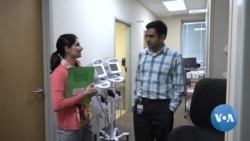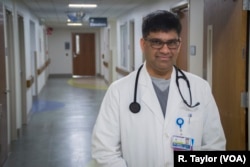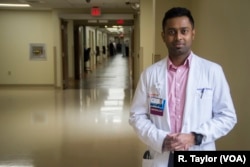"The American dream is no longer alive," Dr. Tarkeshwar Tiwary lamented, looking back on a decade-long journey he has spent chasing a stable future in the United States for his two Indian-born children.
"I feel really demeaned," he said.
A 45-year-old pulmonologist at a hospital in central Pennsylvania, Tiwary is one of 300,000-plus Indian immigrants awaiting legal permanent residency under an employment-based visa.
He is among the nearly 50,000 licensed Indian physicians working in the United States, and he says he feels invested in his rural community of 20,878. But the wait for a green card — a pathway to citizenship — is becoming too long to bear.
"What was promised to me was that if I intend to immigrate, I will be immigrating in a reasonable period of time," Tiwary said. "If I had gone to any other country, like Canada or Australia, I would have been a citizen much, much earlier."
For employment-based visa applicants, the timeline to receive a green card can vary, but none face wait times remotely as long as Indians — up to 151 years for applicants today.
One common route to permanent residency is through an H-1B dual-intent temporary visa, under a "specialty occupation." Indian nationals comprise three-quarters of all H-1B visa holders — a majority in computer-related occupations — but a 7% per-country, per-year limit on employment-based preference green cards has exacerbated wait times across all professions.
"[Wait times have] been increasing since 2003-2004, where there was a big jump and USCIS [U.S. Citizenship and Immigration Services] basically stopped processing them for a couple years," said David Bier, immigration policy analyst at CATO Institute. "It's taken off, increasing up to a decade for people who applied 10 years ago. And that's with serious attrition too. Lots of people have given up."
Like others in his field, Tiwary's decision of whether to stay in the U.S. or leave comes down to what is best for the family. His kids — a daughter entering high school and a son at the University of Pittsburgh — have spent a majority of their lives in the U.S. and "think to themselves that they're American," but will lack any viable employment options in the country as they enter the job market. That is, unless Tiwary's luck changes soon.
Rural communities hit hardest
Should Tiwary and other Indian physicians abandon their efforts and leave the U.S., local residents from Pennsylvania, West Virginia and Maryland who travel more than an hour for specialized or subsidized care could feel the pinch, adding to the growing health-care shortage woes plaguing rural America.
At Chambersburg's Keystone Health, nearly one in five patients lives in poverty and 65% of pediatric patients receive medical assistance, according to President & CEO Joanne Cochran. A federally-qualified health center, Keystone relies heavily on foreign-born family doctors, many of them from India on H-1B and J-1 exchange visitor visas.
"We have Indian doctors in family medicine, psychiatry … pediatrics, internal medicine, infectious disease, urgent care..." Cochran told VOA. "It would be a huge hardship [if they were to leave]."
The foreign-born talent at Keystone includes Dr. Jagdeep Kaur, an addiction psychiatrist and mother of two U.S.-born children, ages 3 and 5. In addition to concern for her aging parents abroad, whom she is unable to sponsor, Kaur's frustration lies in the restrictions that her temporary visa imposes on her work, hampering her ability to grow the scope of her practice and contribute research to the state's opioid epidemic.
Also in limbo is Dr. Mohamed Abdus Samad, a 32-year-old nephrologist at Chambersburg Hospital, whose dialysis patients travel upward of 80 to 100 kilometers (50 to 60 miles) to see him. As the need for kidney specialists increases and his bonds with patients grow stronger, the decision to wait for a green card becomes harder.
"They are grateful for the care that they get, but it also puts pressure on me," said Samad, who is on an H-1B visa through 2020. "If I want to make any move, I have to think about what will happen to those patients."
Christine Newman, a patient of Samad, worries it could take months to book an appointment at another hospital, if he and physicians facing similar predicaments were to leave.
"They're doing what they're supposed to," Newman said. "[The U.S. government] should cut through that red tape and get them in."
Amy Thatcher, a Keystone patient from Spring Run, Pennsylvania, says her Indian doctor, Raghav Tirupathi, saved her life after discovering her hand had become infected by a staph bacteria (MRSA) following a joint replacement procedure. To lose her doctor because of an ongoing visa issue, she said, would be "devastating."
"We base our trust in the people that we see, and we continue to see them," Thatcher said.
'Difficult political lift'
At the present rate, Bier, at the CATO Institute, predicts Indian immigrants will continually drop out in large numbers.
In February, the U.S. House of Representatives introduced the bipartisan Fairness for High-Skilled Immigrants Act of 2019, which seeks to eliminate the per-country cap on employment-based immigrant visas, while increasing the per-country cap on family-based immigrant visas.
But while addressing what Bier calls "nationality-based discrimination," the House bill and a similar measure introduced in the Senate face opposition among some foreign nationals previously unaffected by the backlog.
Last year, the National Iranian American Council (NIAC) sent a letter to corporations lobbying for a previous version of the bill, arguing that it would risk "creating a monopoly over the green card process" and "exacerbate" the impact of the Trump administration's travel ban on Iranian nationals.
"[It's] a difficult political lift," Bier told VOA. "Everyone else has an incentive to keep the system the way it is — where Indians have to wait an indefinite period of time, basically — and everyone else basically gets ushered to the front of the line, ahead of them."
Adding to Indian doctors' dilemmas is the Department of Homeland Security's (DHS) proposed rules to end the President Barack Obama-era H-4 employment authorization program, known as H4 EAD, which allows certain spouses of H-1B visa workers to gain employment. If rescinded, it would affect some 90,000 spouses — mostly Indian women with advanced degrees.
Geetha Potineni, a network security administrator with master's degrees in computer science and biotechnology, is one of them. Her husband, Dr. Venkat Konanki — a nine-year pediatrician at Keystone Health — says the prospect of his wife retaining the ability to work is as important as his own eventual green card prospects.
"Instead of that, how about just going back to India?" Konanki recalls of the conversations at home, with Potineni and their two U.S.-born daughters, ages 7 and 9.
"If there was no discrimination in allotting green cards based on country of birth, I would have never needed H4 EAD," Potineni wrote in an email to VOA. "With two advanced degrees, I never thought of not utilizing my education."
"I've always wanted to contribute both at home and outside of it," she added.













